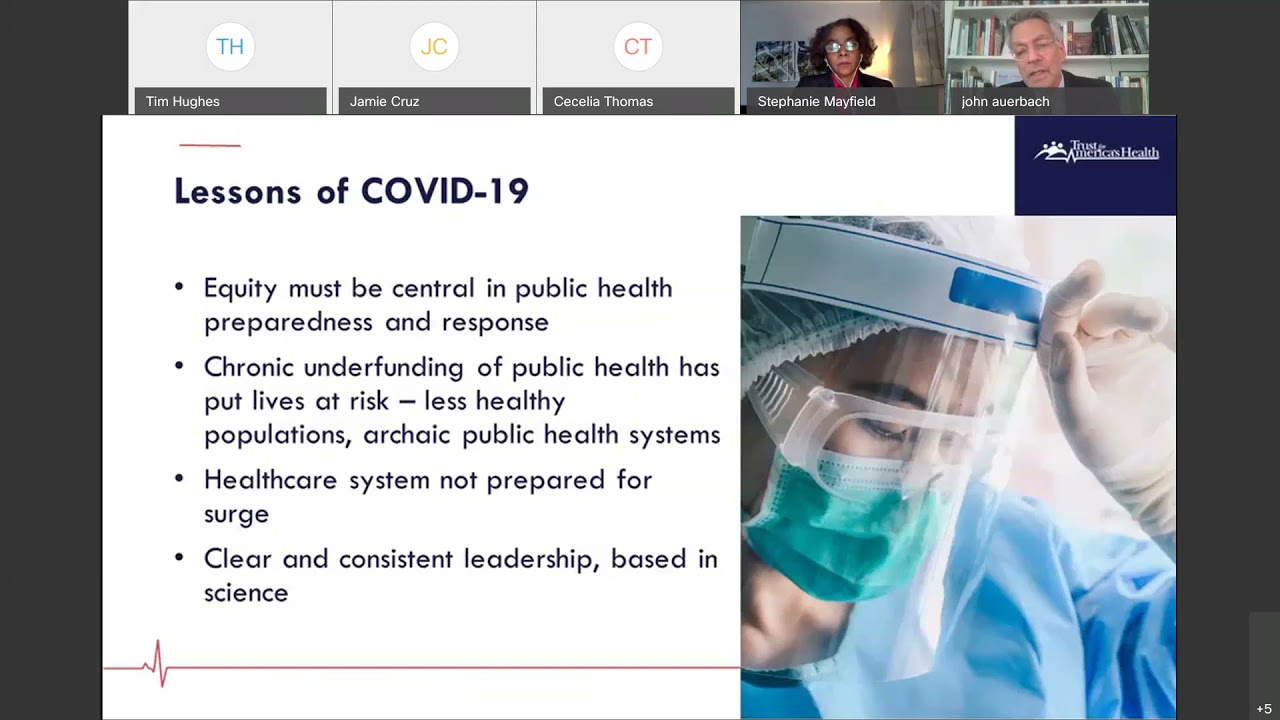La COVID-19 muestra daño crítico de subinversión en infraestructura de salud pública
(Washington, DC) — 10 de marzo de 2021 – La pandemia de COVID-19 ha demostrado claramente que la inversión insuficiente en la preparación para responder a emergencias de salud pública puede costar cientos de miles de vidas y causar estragos en la economía. Un nuevo informe publicado hoy por Trust for America’s Health (TFAH) midió el desempeño de los estados en 10 indicadores clave de preparación para emergencias y encontró espacio para mejorar en todas las jurisdicciones.
El informe Ready or Not 2021: Protecting the Public’s Health from Diseases, Disasters and Bioterrorism midió la preparación de los estados para emergencias de salud de cualquier tipo (no solo la crisis del COVID-19). Este informe colocó a 20 estados y al Distrito de Columbia en una categoría de alto nivel de preparación, 15 estados en un nivel de preparación medio y 15 estados en un nivel de preparación bajo.
Durante casi dos décadas, TFAH ha examinado la preparación para emergencias de salud pública de la nación en este informe anual. Durante ese tiempo, todos los estados han mejorado su preparación para emergencias, pero todos continúan teniendo espacio para un fortalecimiento adicional de sus programas de respuesta de salud pública.
Rendimiento estatal, por nivel de puntuación, 2020
| Performance Tier |
States |
Number of States |
| High Tier |
CO, CT, DC, DE, GA, ID, KS, MA, MD, ME, MS, NC, NE, NM, OK, RI, UT, VA, VT, WA, WI |
20 states and DC |
| Middle Tier |
AL, CA, FL, IA, IL, KY, LA, MI, MN, MT, ND, NJ, OR, TN, TX |
15 states |
| Low Tier |
AK, AR, AZ, HI, IN, MO, NH, NV, NY, OH, PA, SC, SD, WV, WY |
15 states |
“La importancia de este informe es que brinda a los estados datos procesables para adoptar políticas que salven vidas. La crisis de COVID-19 muestra que tenemos mucho más trabajo por hacer para proteger a los estadounidenses de las amenazas a la salud, particularmente en las formas en que el racismo estructural crea y exacerba los riesgos para la salud dentro de las comunidades de color ”, dijo John Auerbach, presidente y director ejecutivo de Trust for Salud de Estados Unidos. “Los estados deben tomar medidas enérgicas para apuntalar su preparación para todo tipo de emergencias de salud pública”.
Si bien los hallazgos del informe no son una medida de la respuesta COVID-19 de ningún estado, demuestran que si bien la preparación de los estados es importante, las emergencias de salud nacionales en la escala de una pandemia requieren un liderazgo y una coordinación federales fuertes, e inversiones a largo plazo en salud pública. infraestructura y mano de obra. Los estados por sí solos, incluso aquellos que ocupan un lugar destacado en este informe, no están lo suficientemente equipados para responder a una pandemia sin ayuda federal, dicen los autores del informe.
El informe encontró:
La mayoría de los estados han hecho preparativos para expandir la atención médica y las capacidades de salud pública en una emergencia, a menudo a través de la colaboración. Treinta y cuatro estados participaron en el Nurse Licensure Compact, en comparación con 26 en 2017. El pacto permite a las enfermeras registradas y las enfermeras prácticas o vocacionales con licencia ejercer en múltiples jurisdicciones con una sola licencia. En caso de emergencia, esto permite a los funcionarios de salud aumentar rápidamente sus niveles de personal. Además, los hospitales de la mayoría de los estados tienen un alto grado de participación en coaliciones de salud. En promedio, el 89 por ciento de los hospitales estaban en una coalición y 17 estados y el Distrito de Columbia tenían participación universal, lo que significa que todos los hospitales de la jurisdicción eran parte de una coalición. Dichas coaliciones unen a los hospitales y otras instalaciones de atención médica con la gestión de emergencias y los funcionarios de salud pública para planificar y responder a los incidentes. Finalmente, todos los estados y el Distrito de Columbia tenían laboratorios de salud pública que tenían planes para una gran afluencia de necesidades de pruebas. Esta capacidad de aumentar la capacidad de prueba de laboratorio durante la crisis de COVID-19 fue extremadamente crítica.
La mayoría de los estados están acreditados en las áreas de salud pública, manejo de emergencias o ambos. A diciembre de 2020, la Junta de Acreditación de Salud Pública (PHAB) o el Programa de Acreditación de Gestión de Emergencias (EMAP) acreditaron 42 estados y el Distrito de Columbia; 29 estados y el Distrito de Columbia fueron acreditados por ambos grupos, un aumento neto de uno desde noviembre de 2019. Ambos programas ayudan a garantizar que los sistemas necesarios de preparación y respuesta ante emergencias estén en su lugar y con personal calificado.
Las tasas de vacunación contra la influenza estacional, aunque aún son demasiado bajas, han aumentado significativamente. La tasa de vacunación contra la influenza estacional entre los estadounidenses de 6 meses o más aumentó del 42 por ciento durante la temporada 2017-2018 al 52 por ciento durante la temporada 2018-2019, pero aún está por debajo de la tasa de vacunación objetivo del 70 por ciento establecida por Healthy People 2030.
En 2019, solo el 55 por ciento de los residentes estatales empleados, en promedio, usaron tiempo libre remunerado, el mismo porcentaje que en 2018. Aquellos sin licencia remunerada tienen más probabilidades de trabajar cuando están enfermos y corren el riesgo de propagar la infección. Esto se volvió particularmente relevante durante la pandemia de COVID-19, ya que el aislamiento y la cuarentena son herramientas importantes para controlar el brote.
La mayoría de los residentes que obtuvieron el agua de su hogar a través de un sistema de agua comunitario tenían acceso a agua potable. En promedio, solo el 5 por ciento de los residentes del estado utilizó un sistema de agua comunitario en 2019 que no cumplía con todos los estándares de salud aplicables.
El informe incluye recomendaciones de acciones por parte de los legisladores federales y estatales para mejorar la preparación para emergencias de salud pública de la nación en siete áreas prioritarias:
- Proporcionar financiación suficiente y estable para la seguridad de la salud pública nacional y mundial.
- Fortalecer las políticas y los sistemas para prevenir y responder a brotes y pandemias.
- Construir comunidades resilientes y promover la equidad en salud en general y en la preparación.
- Asegurar liderazgo, coordinación y fuerza laboral efectivos en salud pública.
- Acelerar el desarrollo y la distribución, incluida la distribución de última milla, de contramedidas médicas.
- Fortalecer la capacidad del sistema de salud para responder y recuperarse durante y de emergencias de salud.
- Prepárese para las amenazas ambientales y el clima extremo.
El informe de la serie Ready or Not está financiado por la Fundación Robert Wood Johnson con el apoyo adicional de The California Endowment, W.K. Fundación Kellogg y Fundación Kresge.
###
Trust for America’s Health es una organización no partidista sin fines de lucro que promueve la salud óptima para cada persona y comunidad y hace de la prevención de enfermedades y lesiones una prioridad nacional. Twitter: @HealthyAmerica1


